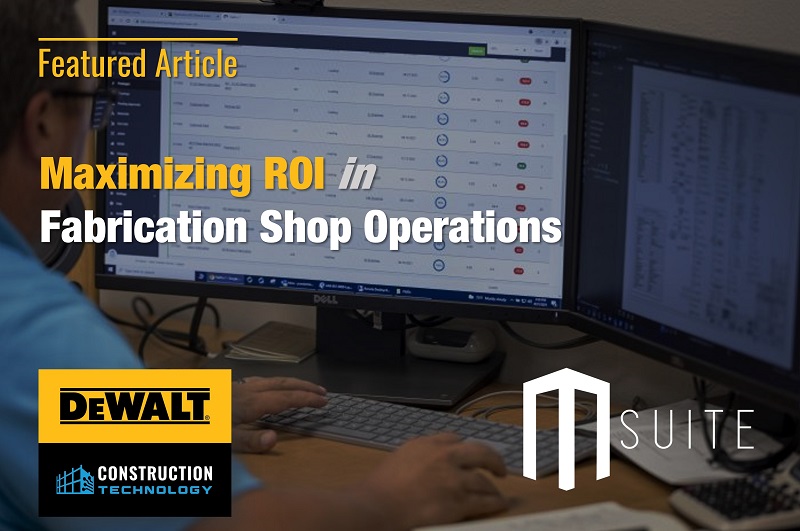In the competitive world of manufacturing and fabrication, achieving a healthy return on investment (ROI) is paramount to long-term success. Maximizing ROI isn’t just about increasing revenue; it’s about optimizing every aspect of your fabrication shop’s operations to ensure that every dollar spent generates the greatest possible return. This article will identify strategies and best practices for maximizing ROI in fabrication shop operations.
1. Assessing Current Operations
The journey to maximizing ROI begins with a thorough assessment of your current operations. This involves identifying your key performance indicators (KPIs), understanding your current processes, and measuring your existing ROI.
Start by defining your KPIs. These include metrics such as production efficiency, labor productivity, material utilization, and waste reduction. By establishing clear KPIs, you can track progress and identify areas for improvement.
2. Implementing Lean Principles
Lean manufacturing principles have revolutionized businesses’ operations, and fabrication shops are no exception. Lean principles focus on reducing waste, improving efficiency, and enhancing the overall value of your processes.
Identify and eliminate the seven wastes in your operations: overproduction, inventory, waiting, motion, transportation, overprocessing, and defects. Lean principles can help you streamline fabrication processes, reduce costs, and improve ROI.
3. Optimizing Equipment and Technology
Your fabrication shop’s equipment and technology significantly affect your ROI. Outdated machinery can lead to inefficiencies, increased downtime, and higher maintenance costs.
Invest in modern equipment and technology to improve your production capacity and efficiency. This might include upgrading machinery, incorporating automation and robotics, and leveraging the Internet of Things (IoT) for real-time data monitoring and analysis.
4. Workforce Productivity
Your workforce is your most valuable asset in maximizing ROI. Investing in your employees’ training and skill development can increase productivity and reduce errors. Employees that are motivated and engaged are more likely to contribute to a positive ROI and grow with your company.
It’s important for management to ensure employees have the right resources, support, and tools to do their jobs efficiently. Implement safety measures to prevent accidents and downtime, which can negatively impact your ROI. Retaining key talent is more important now than ever, and an investment into their workflows helps dramatically.
5. Supply Chain and Inventory Management
Effective supply chain and inventory management can significantly impact your ROI. Streamlining supply chain processes, optimizing inventory levels, and implementing just-in-time (JIT) inventory practices can reduce carrying costs and waste.
Establish strong vendor relationships to negotiate favorable terms and ensure a consistent supply of materials. You can minimize disruptions and improve operational efficiency by managing your supply chain effectively.
6. Quality Control and Assurance
Maintaining high-quality standards is essential for maximizing ROI. Implement robust quality control and assurance processes to reduce defects, rework, and customer returns.
Regularly inspect and test your products to ensure they meet quality specifications. By reducing the cost of poor quality, you can improve your ROI and enhance your reputation for delivering quality products.
7. Energy Efficiency and Sustainability
Sustainability practices not only benefit the environment but also your bottom line. Implement energy-efficient technologies and techniques to reduce energy consumption and lower operating costs.
Consider adopting sustainable materials and manufacturing processes. Many customers now prefer environmentally friendly products, which can open new markets and increase demand for your fabrication shop’s services.
8. Financial Management
Sound financial management is a fundamental aspect of maximizing ROI. Create and adhere to a budget that includes all operational expenses, from labor and materials to overhead costs.
Cash flow should be monitored regularly to ensure your business has the capital to operate smoothly. Utilizing financial metrics and KPIs such as return on equity (ROE) and return on assets (ROA) to assess the efficiency of your investments and capital allocation.
9. Compliance and Regulations
Compliance with industry standards and regulations is non-negotiable, and failure to meeting requirements can result in major fines, legal issues, and reputational damage.
Stay informed about relevant regulations and invest in the necessary processes and technologies to ensure compliance. Compliance not only avoids costly penalties but also enhances customer trust and satisfaction.
10. Case Studies and Success Stories
To illustrate the real-world impact of maximizing ROI in fabrication shop operations, let’s explore a few case studies and success stories.
Case Study 1: MSUITE Helps Shapiro & Duncan Save $1.4M per Year in the Shop. Chris Canter, Director of Virtual Design and Fabrication, faced a high-growth operational challenge as he took over VDC and Fabrication Operations at Shapiro & Duncan. Shapiro & Duncan increased productivity by quickly identifying bottlenecks in their workflow and making the necessary adjustments to speed up production. Implementing MSUITE brought substantial returns on investment in several areas. Read more here.
Case Study 2: McKinstry is Changing the Game. McKinstry implemented MSUITE to solve two challenges: improving fabrication shop productivity insights and gaining a deeper connection between VDC and Fabrication teams. McKinstry’s Shop leadership team needed greater visibility on production to improve productivity and communication. Read more here.
Conclusion
Maximizing ROI in fabrication shop operations requires a holistic approach that touches every aspect of your business. You can position your fabrication shop by assessing current operations, implementing lean principles, optimizing equipment and technology, focusing on workforce productivity, managing the supply chain effectively, ensuring quality control, embracing sustainability, practicing sound financial management, and staying compliant with regulations.
Remember that achieving the highest possible ROI is an ongoing journey. Continuously monitor your KPIs, adapt to industry changes, and embrace emerging technologies and best practices. By doing so, you’ll maximize your ROI and secure a competitive edge in the ever-evolving world of fabrication.









